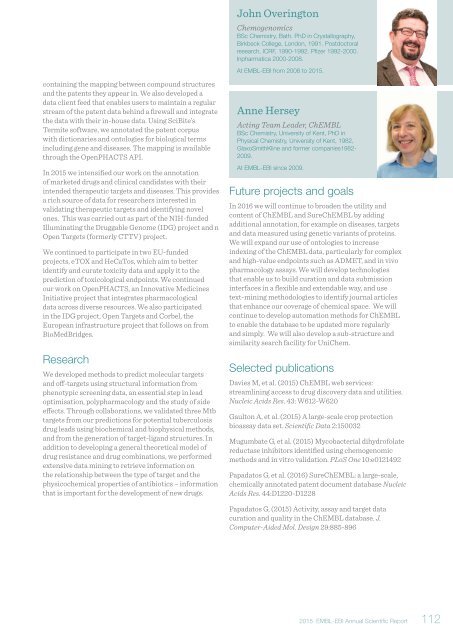Annual Scientific Report 2015
EMBL_EBI_ASR_2015_DigitalEdition
EMBL_EBI_ASR_2015_DigitalEdition
You also want an ePaper? Increase the reach of your titles
YUMPU automatically turns print PDFs into web optimized ePapers that Google loves.
containing the mapping between compound structures<br />
and the patents they appear in. We also developed a<br />
data client feed that enables users to maintain a regular<br />
stream of the patent data behind a firewall and integrate<br />
the data with their in-house data. Using SciBite’s<br />
Termite software, we annotated the patent corpus<br />
with dictionaries and ontologies for biological terms<br />
including gene and diseases. The mapping is available<br />
through the OpenPHACTS API.<br />
In <strong>2015</strong> we intensified our work on the annotation<br />
of marketed drugs and clinical candidates with their<br />
intended therapeutic targets and diseases. This provides<br />
a rich source of data for researchers interested in<br />
validating therapeutic targets and identifying novel<br />
ones. This was carried out as part of the NIH-funded<br />
Illuminating the Druggable Genome (IDG) project and n<br />
Open Targets (formerly CTTV) project.<br />
We continued to participate in two EU-funded<br />
projects, eTOX and HeCaTos, which aim to better<br />
identify and curate toxicity data and apply it to the<br />
prediction of toxicological endpoints. We continued<br />
our work on OpenPHACTS, an Innovative Medicines<br />
Initiative project that integrates pharmacological<br />
data across diverse resources. We also participated<br />
in the IDG project, Open Targets and Corbel, the<br />
European infrastructure project that follows on from<br />
BioMedBridges.<br />
Research<br />
We developed methods to predict molecular targets<br />
and off-targets using structural information from<br />
phenotypic screening data, an essential step in lead<br />
optimisation, polypharmacology and the study of side<br />
effects. Through collaborations, we validated three Mtb<br />
targets from our predictions for potential tuberculosis<br />
drug leads using biochemical and biophysical methods,<br />
and from the generation of target-ligand structures. In<br />
addition to developing a general theoretical model of<br />
drug resistance and drug combinations, we performed<br />
extensive data mining to retrieve information on<br />
the relationship between the type of target and the<br />
physicochemical properties of antibiotics – information<br />
that is important for the development of new drugs.<br />
John Overington<br />
Chemogenomics<br />
BSc Chemistry, Bath. PhD in Crystallography,<br />
Birkbeck College, London, 1991. Postdoctoral<br />
research, ICRF, 1990-1992. Pfizer 1992-2000.<br />
Inpharmatica 2000-2008.<br />
At EMBL-EBI from 2008 to <strong>2015</strong>.<br />
Anne Hersey<br />
Acting Team Leader, ChEMBL<br />
BSc Chemistry, University of Kent, PhD in<br />
Physical Chemistry, University of Kent, 1982,<br />
GlaxoSmithKline and former companies1982-<br />
2009.<br />
At EMBL-EBI since 2009.<br />
Future projects and goals<br />
In 2016 we will continue to broaden the utility and<br />
content of ChEMBL and SureChEMBL by adding<br />
additional annotation, for example on diseases, targets<br />
and data measured using genetic variants of proteins.<br />
We will expand our use of ontologies to increase<br />
indexing of the ChEMBL data, particularly for complex<br />
and high-value endpoints such as ADMET, and in vivo<br />
pharmacology assays. We will develop technologies<br />
that enable us to build curation and data submission<br />
interfaces in a flexible and extendable way, and use<br />
text-mining methodologies to identify journal articles<br />
that enhance our coverage of chemical space. We will<br />
continue to develop automation methods for ChEMBL<br />
to enable the database to be updated more regularly<br />
and simply. We will also develop a sub-structure and<br />
similarity search facility for UniChem.<br />
Selected publications<br />
Davies M, et al. (<strong>2015</strong>) ChEMBL web services:<br />
streamlining access to drug discovery data and utilities.<br />
Nucleic Acids Res. 43: W612-W620<br />
Gaulton A, et al. (<strong>2015</strong>) A large-scale crop protection<br />
bioassay data set. <strong>Scientific</strong> Data 2:150032<br />
Mugumbate G, et al. (<strong>2015</strong>) Mycobacterial dihydrofolate<br />
reductase inhibitors identified using chemogenomic<br />
methods and in vitro validation. PLoS One 10:e0121492<br />
Papadatos G, et al. (2016) SureChEMBL: a large-scale,<br />
chemically annotated patent document database Nucleic<br />
Acids Res. 44:D1220-D1228<br />
Papadatos G, (<strong>2015</strong>) Activity, assay and target data<br />
curation and quality in the ChEMBL database. J.<br />
Computer-Aided Mol. Design 29:885-896<br />
<strong>2015</strong> EMBL-EBI <strong>Annual</strong> <strong>Scientific</strong> <strong>Report</strong> 112


